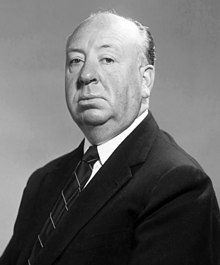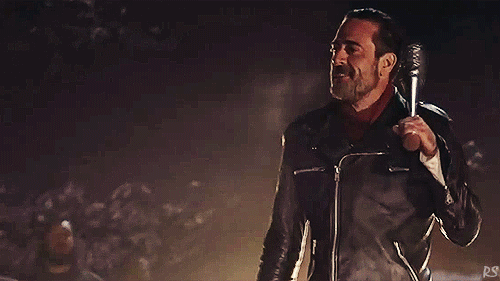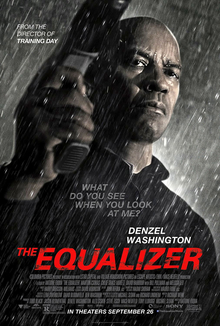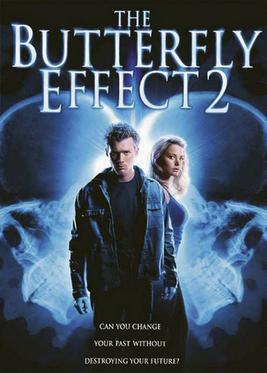
Alfred Hitchcock (Psycho, 1960)
Alfred Hitchcock pioneered many elements of the suspense and psychological thriller genres. He had a successful career in British cinema with both silent films and early talkies and became renowned as England's best director. Hitchcock moved to Hollywood in 1939. Hitchcock's Rear Window and Psycho are one of the best thriller films that he had ever created.
Christopher Nolan (The Dark Knight, 2005-2012)
.jpg) Nolan's visual style often emphasises urban settings, men in suits, muted colors, dialogue scenes framed in wide close-up with a shallow depth of field and modern locations and architecture. Aesthetically, the director favours deep, evocative shadows, documentary-style lighting, natural settings and real filming locations over studio work. Nolan has noted that all of his films are heavily influenced by film noir. (mood of pessimism, fatalism, and menace)
Nolan's visual style often emphasises urban settings, men in suits, muted colors, dialogue scenes framed in wide close-up with a shallow depth of field and modern locations and architecture. Aesthetically, the director favours deep, evocative shadows, documentary-style lighting, natural settings and real filming locations over studio work. Nolan has noted that all of his films are heavily influenced by film noir. (mood of pessimism, fatalism, and menace) Christopher Nolan is the man who reboots the blockbusters, He is one of the few directors who can walk into a Hollywood studio with an idea and come out with $200m. So will Nolan’s latest film, Interstellar was a huge success earning $675 million dollars from a budget of $165 million dollars. Batman Begins (2005) was also one of his biggest successful films, he earned $374 million dollars from a $150 million dollars budget earning him more than twice the amount he has spent on making this film.
 David Fincher (Seven, 1995, The Game 1997)
David Fincher (Seven, 1995, The Game 1997)
Fincher likes to use a lot of different camera movements with computer-generated imagery, commission intricate sets, get heavily involved in post-production, and re-shoot footage after the principal photography has wrapped. He does not normally use hand-held cameras when he shoots a film, preferring cameras on a tripod. His most frequent use of a hand-held camera was for his film Seven, in which five scenes were shot that way. Secondly, Fincher likes to confuse audiences with his camerawork. Sometimes, it is difficult to determine if a shot is human-controlled, motion-controlled or computer-generated imagery. Thirdly, Close-ups are very common in Fincher's films, extreme close-ups. Fourthly, he tries not to move his cameras as much as possible.
Michael Mann (Heat 1995, Blackhat 2015)
 Mann's films often feature male protagonists, usually highly gifted and independent-minded professionals who struggle to reconcile their mental lives with the demands, both benign and malign, of the exterior world. Importantly, his films often involve a tragic rather than a happy ending, such as in Miami Vice, when of the two undercover police officers, one has his girlfriend (also an undercover officer) come out of a coma and the other tearfully separates from his romantic interest. Mann's films contain fast-paced, artful scenes that strongly depend on powerful music, where often two opposing sides intermix, such as undercover policework and undercover drug trafficking, so that it is hard to distinguish between the two. For example, in Heat, the police detective invites the criminal to meet for coffee, where they discuss their affairs like old business partners. Often it is hard to distinguish between opposing sides (e.g. police vs. criminals), where the actions, dress, and mannerisms of the characters are extremely similar. Also, Mann's work often involves landscapes and modes where the heroic protagonists occupy a somewhat secret world, away from ordinary concerns (law, life and death, money, daily-life survival duties, family duties, and so on), where the secret world may or may not coincide with ordinary reality. Protagonists often find impassioned romantic interests which are severed under tragic situations near the end of the film such as: (Last of the Mohicans, Heat, Collateral, Miami Vice, Public Enemies). Overall, Mann's films mix artistry (via music, stylishness and emotional intensity) with strong violence and noir-like stoicism.
Mann's films often feature male protagonists, usually highly gifted and independent-minded professionals who struggle to reconcile their mental lives with the demands, both benign and malign, of the exterior world. Importantly, his films often involve a tragic rather than a happy ending, such as in Miami Vice, when of the two undercover police officers, one has his girlfriend (also an undercover officer) come out of a coma and the other tearfully separates from his romantic interest. Mann's films contain fast-paced, artful scenes that strongly depend on powerful music, where often two opposing sides intermix, such as undercover policework and undercover drug trafficking, so that it is hard to distinguish between the two. For example, in Heat, the police detective invites the criminal to meet for coffee, where they discuss their affairs like old business partners. Often it is hard to distinguish between opposing sides (e.g. police vs. criminals), where the actions, dress, and mannerisms of the characters are extremely similar. Also, Mann's work often involves landscapes and modes where the heroic protagonists occupy a somewhat secret world, away from ordinary concerns (law, life and death, money, daily-life survival duties, family duties, and so on), where the secret world may or may not coincide with ordinary reality. Protagonists often find impassioned romantic interests which are severed under tragic situations near the end of the film such as: (Last of the Mohicans, Heat, Collateral, Miami Vice, Public Enemies). Overall, Mann's films mix artistry (via music, stylishness and emotional intensity) with strong violence and noir-like stoicism.






